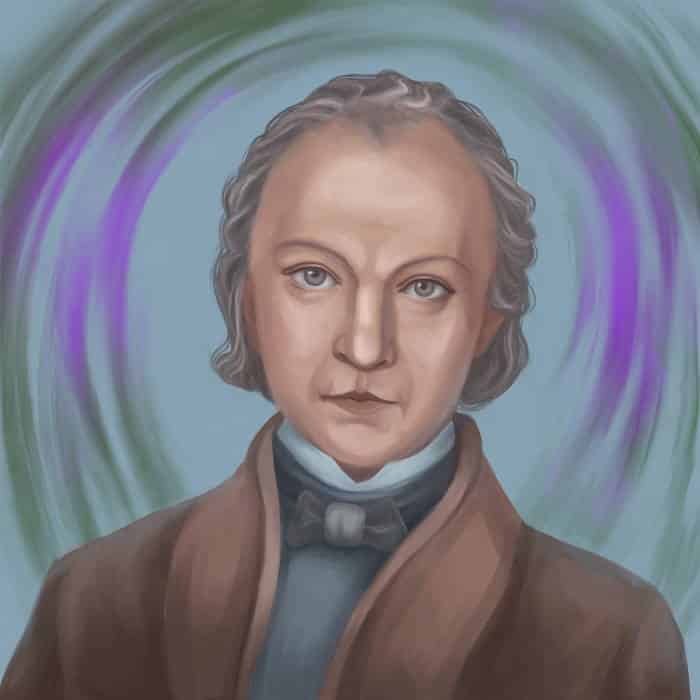William Blake was unrecognized during his lifetime, but since his death, he has become known as one of the greatest artistic and literary geniuses of the 18th and 19th centuries. Blake was multi-talented, working as a poet, engraver, painter, and illustrator. He was renowned for his creativity and ability to push the envelope of what was possible with poetry. He combined illustration and the written word to create pieces of visual artistry. His works would often have philosophical and mystical undercurrents.
His emphasis on visual arts separated him from his peers, who focused only on the written verse. Unlike some of his contemporaries, Blake did not find literary success for his entire life. Tragically, he only garnered his reputation as one of the greatest creatives to come out of Britain posthumously. Later critics, such as 21st-century critic Jonathan Jones, cement this notion and have gone as far as to say that Blake is the greatest artist Britain has ever produced.
Life Facts
- William Blake was born in Soho, London, England, in November 1757.
- He was apprenticed to a printmaker for seven years.
- Blake married Catherine Sophia Boucher.
- In 1785, Blake co-opened a print shop.
- William Blake died in August of 1827.
Interesting Facts
- Blake was charged with assault and sedition.
- He saw visions at Westminster Abbey.
- He was called “an unfortunate lunatic” after an exhibition of his prints.
- Blake remained unrecognized during his lifetime.
- He believed his brother instructed him, from the afterlife, in the method of “illuminated printing.”
Famous Poems
- ‘The Tyger’ was published in 1794 in ‘Songs of Experience.’ It is widely anthologized alongside ‘The Lamb.’ The poem questions the cruel elements of God’s creation, the tiger being the main example. Throughout, the child tries to reconcile the tiger with the kinder, softer elements to be found in the world.
- ‘The Lamb’ is the companion piece to Blake’s ‘The Tyger.’ It uses the lamb as an image of God’s goodness and his overarching will. A child is addressing the title animal throughout the poem. They speak to the creature and take note of its soft wool and the simple noises it makes.
- ‘A Poison Tree’ was also published in 1794 in William Blake’s ‘Songs of Experience.’ Blake’s speaker considers what anger is and two different ways of confronting it. One might move past it by speaking about its cause. Alternatively, the anger takes root through the image of a tree that, unfortunately, bears poisoned apples.
- ‘The Sick Rose’ should be read with an eye on the way that the extended metaphor at the heart of the poem works. The speaker compares the rose, a symbol of nature, beauty, and fragility, to a woman’s innocence or chastity. The value of a relationship with a woman was defined by whether or not that woman has had sex. When the rose is ‘sick,‘ it has lost its purity or its virginity.
- ‘London’ was published in ‘Songs of Experience’ in 1794. It describes the difficulties of London life while the speaker moves through the city. He travels to the River Thames and takes note of the solemn and resigned faces of his fellow Londoners. There is genuine pain in the hearts of men, women, and children.
Explore more William Blake poems.
Early Life
William Blake was born in Soho, London, England, in November 1757. He was the third of seven children (two of whom died in infancy) born to his parents, James and Catherine, who were part of the Church of England. His father, James, was a hosier by trade, which allowed Blake an upbringing of sufficient means. The family resided at 28 Broad Street in London.
Blake only attended school for a few years, managing to learn to read and write, before he left at the age of ten. He was educated by his mother for the rest of his childhood. It was during this same period of time that Blake claimed to have had his first vision (a tree full of angels), an experience that would become a reoccurring theme in his life.
As he aged, he began to study engraving and developed a love for Gothic art. These elements would prove influential in his later paintings and drawings. He was enrolled by his parents in drawing classes at Pars’s drawing school in the Strand. In this institution, he was able to freely read any subject he chose as well as explore his poetry. Blake’s poetry work from this period showed the influence of poets such as Edmund Spenser as well as elements of scripture and the Psalms.
In 1772, Blake began an apprenticeship with an engraver known as James Basire. He remained in these circumstances for the duration of the term, a total of seven years. At one point, the young artist was sent to Westminster Abbey. He would later tell of experiencing a number of visions there. These included: Christ and his Apostles, as well as chanting and religious processions. After completing his apprenticeship, Blake was still at the ripe age of 21. He moved on to the Royal Academy.
Literary Career
Blake’s ‘Poetical Sketches’ was published in 1783. This was a collection he had been working on for over 14 years. Following his father’s death, Blake inherited a sum of money, which he put towards starting a new enterprise. Blake took the money and co-opened a print shop with his friend James Parker and began working with the publisher Joseph Johnson, who was seen as a radical.
The association between himself and Johnson allowed Blake to build and cultivate a prominent circle of people in the literary and political spheres. He most notably met with Mary Wollstonecraft, William Godwin, Joseph Priestly, and Thomas Paine. Many of these associates were considered some of the most radical thinkers of his day. Soon after, in the same year, Blake began the manuscript, An Island on the Moon, a work that was never completed.
In the late 1790s, Blake published a number of his “prophetic” books. These works were illuminated in his characteristic style and contained poetic and narrative texts. Some of these volumes include ‘Visions of the Daughters of Albion,’ ‘The First Book of Urizen,’ and the continental prophecies: ‘America a Prophecy,’ ‘Europe a Prophecy,’ and ‘The Song of Los.’
In 1819, Blake began a series of sketches that were referred to as “visionary heads.” These works depicted historical and imaginary figures Blake claimed came and sat for him. By the mid-1800s, he had completed more than 100 individual works. They included King Solomon, the magician Merlin, Owen Glendower, and William Wallace.
The mid-1800s also saw Blake create engravings for an illustrated edition of the Book of Job and Dante’s ‘Inferno.‘

To see the world in a grain of sand, and to see heaven in a wild flower, hold infinity in the palm of your hands, and eternity in an hour.
William Blake Quote
Marriage
In 1782, Blake married Catherine Boucher. He taught the young woman how to read, write, and draw. She remained his steadfast supporter throughout his life. They moved to Felpham together in 1803, a place that would become prominent within his work.
Writing Career and Relationships
In the later years of the 18th century, Blake suffered great trauma when his brother, Robert, died from tuberculosis at only 24. The poet claimed to have seen his brother’s spirit rise from his body and pass through the ceiling. This experience was deeply influential, especially after Robert reappeared to Blake and instructed him in a new method of printing his works. A process that would come to be called “illuminated printing.” For some of his works, Blake would use copper plates to print, then watercolors to finish the piece. This way of working would be utilized in his best-known collection ‘Songs of Innocence and Experience.‘
In the early 1800s, Blake moved to work alongside William Hayley. Their relationship did not last long— souring around the same time Blake ran into legal trouble. In an incident involving a soldier on his property, Blake was charged with assault and sedition. He was forced to take on a lawyer and was luckily acquitted in 1804.
Soon after his troubles, Blake and Catherine moved back to London. It was here he began to write and illustrate ‘Jerusalem.’ This work would take a number of years to complete, spanning from 1804 to 1820 and beyond, as later edited versions were released.
It was also during this period that Blake began showing his work at exhibitions. The pieces were met with either silence or negative criticism. At one point, he was even referred to as “an unfortunate lunatic.” The reviews hit Blake hard, impacting his mental health and keeping him from showing any further illustrative works.
Later Life
During his later years, William Blake was struck with poverty, never gaining any wealth from his works. However, in 1818, Blake was still involving himself within literary circles, befriending a group of young writers called “the Ancients.” One of these was John Linnell, who became close to Blake and not only offered him work but aided him in financial matters. It was Linnell who later offered Blake the chance to produce illustrations for Dante’s ‘Divine Comedy.’ Blake was initially commissioned to complete this task in 1825 but could only work on them until his death in 1827.
Death
Blake’s death came after repeating occurrences of an undiagnosed illness. He died in August of 1827, leaving behind a number of unfinished collections. These included illustrations for John Bunyan’s ‘Pilgrim’s Progresses,’ and Dante’s ‘Inferno,’ as well as an illustrated manuscript of the Book of Genesis.
Influence from other Poets
William Blake was notably influenced by writers such as Dante Alighieri, William Shakespeare, and John Milton. Since his death, he has inspired countless other poets throughout the centuries.
FAQs
William Blake is known for his poetry, which combined excellent illustration and well-executed verse. He is considered by modern critics as arguably the greatest artist to come out of Britain. He created famous works such as; ‘Songs of Innocence and Experience,’ ‘The Tyger,’ and ‘The Lamb.’
William Blake can most certainly be considered a romantic poet, alongside other pioneers such as William Wordsworth and Samuel Taylor Coleridge. Blake’s work had all the characteristics of Romanticism, with lyrical, song-like verses and a focus on beauty, nature, and human emotion.
William Blake was not only unique in his style but in his presentation of poetry. He chose to write in a lyrical, song-like manner, whereas others would write in a more traditional story form. Alongside this, he would illustrate his poems, creating prints to supplement them. This separated him from poets that would focus purely on the written word.
William Blake was consistently against the way society was run during his time period. He took the stance that society was more punishing in adulthood than it needed to be due to the rise of institutions and corruption that came with that. He also saw childhood and innocence as something that was quickly lost.
William Blake used a wide array of imagery and symbolism to portray the romantic ideas of his poems. He focused on the human experience, emotion, nature, and beauty. These are all typical features of Romantic poetry.



Very helpful site💟
Thank you.